Discover vital warning signs of pancreas disorders to boost awareness and health. Stay informed for early detection and prevention.
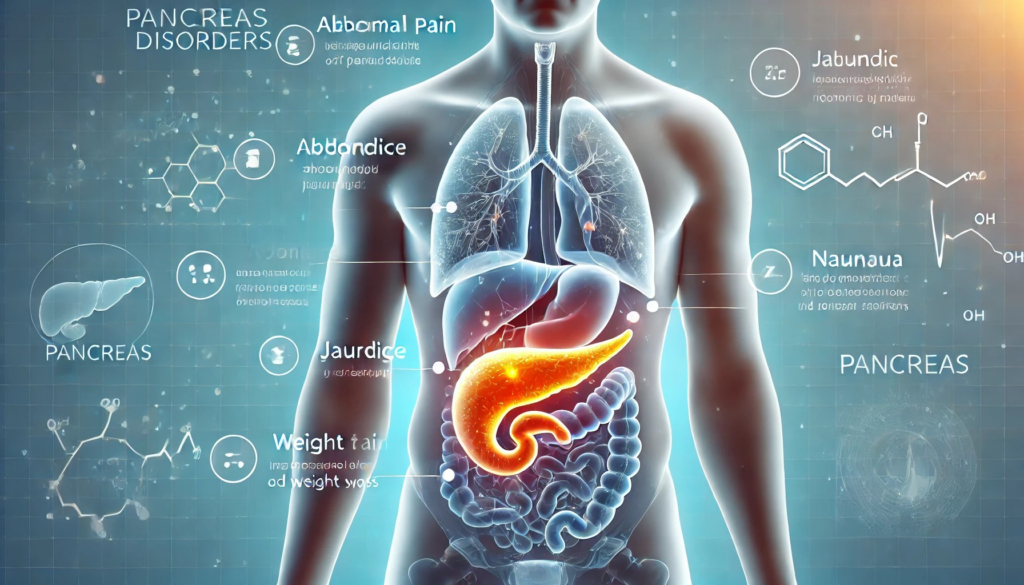
Table of Contents
“Pancreas Disorders: 9 Warning Signs to Watch For”
The pancreas is a key organ for digestion and health. Disorders in the pancreas can be serious and even deadly if not treated. It’s important to know the symptoms of pancreas disorders to get help quickly. Early signs of pancreatic disease are often subtle, but knowing them can make a big difference in health.
Knowing the symptoms of pancreas disorders and pancreatic disease can help you get medical help fast. Spotting problems early lets you take charge of your health and avoid serious issues. This article will cover the warning signs of pancreas disorders, helping you understand symptoms and early signs.
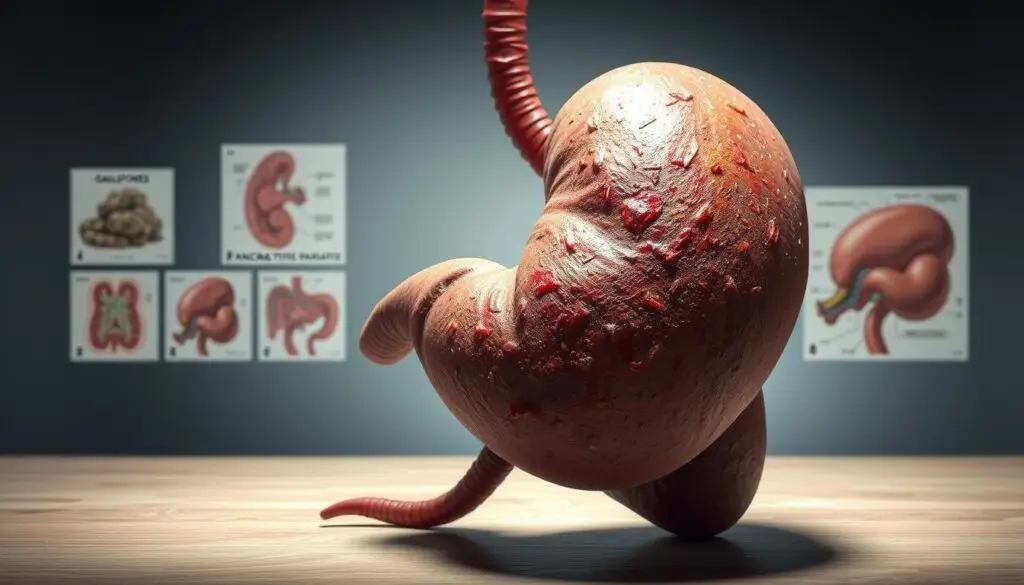
Introduction to Pancreas Disorders
Pancreas disorders can happen to anyone, at any age. Knowing the symptoms and early signs of pancreatic disease is key to staying healthy. By recognizing these signs, you can take steps to prevent or manage pancreas disorders, avoiding long-term damage.
Key Takeaways
- Recognizing pancreas disorders symptoms is essential for prompt medical attention
- Early signs of pancreatic disease can be subtle but significant
- Understanding pancreas disorders symptoms can improve health outcomes
- Pancreas disorders can affect anyone, regardless of age or health status
- Being informed about pancreas disorders symptoms can help prevent or manage the condition
Understanding Your Pancreas: A Vital Digestive Organ
The pancreas is key to our health, especially for digestion. It sits behind the stomach and makes enzymes for digestion and hormones for blood sugar. Knowing what the pancreas does helps us spot problems early.
Studies show the pancreas is vital for digestion. It makes enzymes to break down food, helping us get nutrients. If this process fails, we might face issues like malabsorption or diarrhea.
Key Functions of the Pancreas
- Producing digestive enzymes to break down food
- Regulating blood sugar levels through hormone production
- Maintaining proper nutrient absorption
Importance in Digestive Health
A healthy pancreas is crucial for avoiding digestive problems. Signs like stomach pain or bowel changes can mean trouble. Knowing the pancreas’s role in digestion helps us keep it healthy.
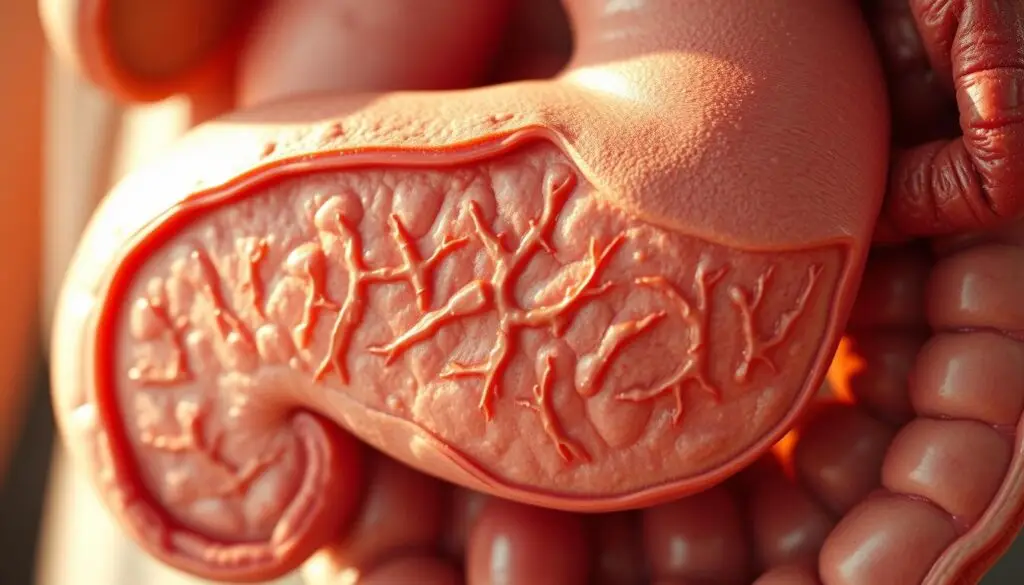
Common Pancreatic Disorders
Disorders like pancreatitis or pancreatic cancer can harm our health. Spotting signs like digestive issues or pancreatic problems early is key. This helps in getting the right treatment sooner.
Common Pancreas Disorders Symptoms and Warning Signs
It’s important to know the signs of pancreas problems early. This can lead to quick treatment. Symptoms like abdominal pain and digestive issues are common signs of pancreas disorders.
If you notice these symptoms, see a doctor right away. They can check you and find out what’s wrong. Early detection and treatment can make a big difference.
Here are some common symptoms and warning signs of pancreas disorders:
- Abdominal pain or tenderness
- Nausea and vomiting
- Diarrhea or constipation
- Changes in appetite or weight
- Fatigue or weakness
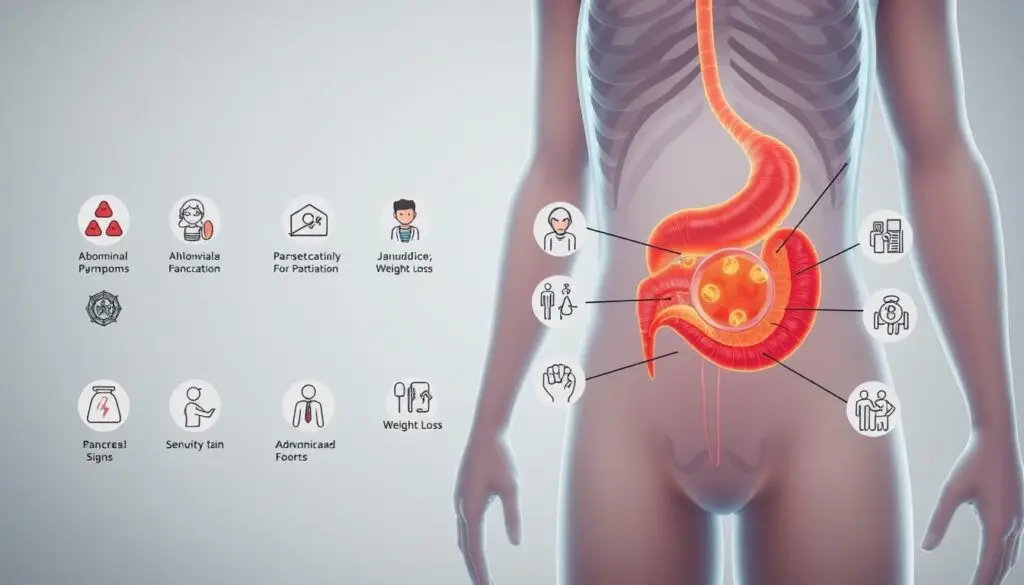
Knowing the signs of pancreas problems is key to keeping your pancreas healthy. By recognizing symptoms early, you can get help sooner. This can lead to better health and treatment outcomes.
Abdominal Pain: The Primary Red Flag
Abdominal pain is a common sign of pancreas problems. It’s important to know the signs of pancreatic pain. This pain can show if there’s a problem with your pancreas.
When you feel abdominal pain, notice where it is and how bad it is. Also, how long it lasts is important. This helps figure out if it’s related to your pancreas.
Consider the pain’s location and how severe it is. It can be in the upper abdomen or even in the lower back. Knowing these details helps spot potential pancreas issues.
Characteristics of Pancreatic Pain
- Persistent or recurring pain in the upper abdomen
- Pain that radiates to the back or worsens after eating
- Abdominal tenderness or guarding
When Pain Signals Emergency
If your pain is very bad, doesn’t go away, or comes with nausea, vomiting, or fever, it’s a sign of a serious problem. You should get medical help right away. This can prevent worse problems and help you get the right treatment.
By knowing the signs of pancreatic pain, you can take care of your pancreas. This helps you deal with any illness symptoms early on.
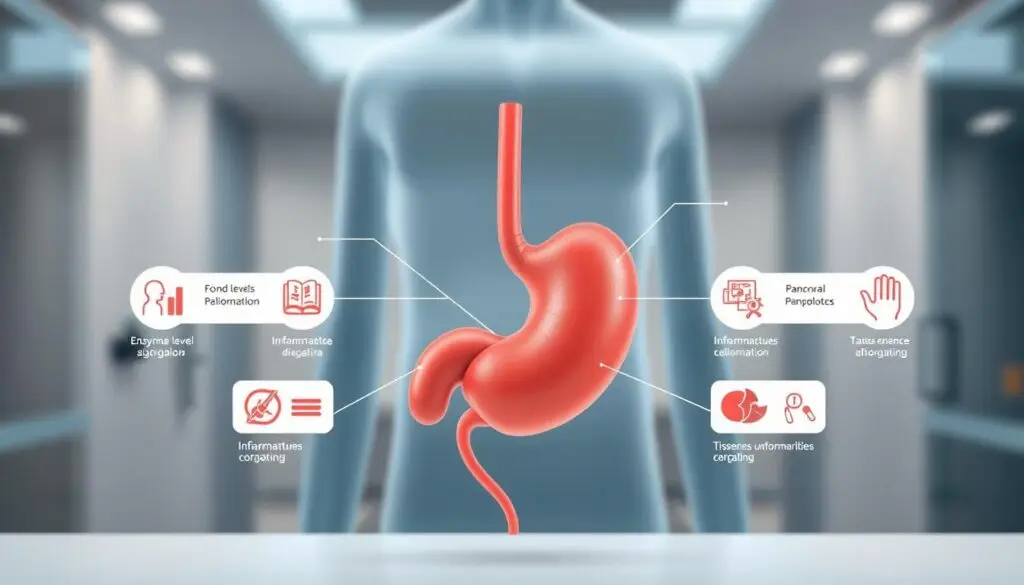
Digestive Issues and Changes in Bowel Habits
Signs of pancreatic dysfunction can show up in many ways, like changes in bowel habits. These signs might mean there’s a problem with the pancreas. Studies have found that pancreas issues can lead to diarrhea, constipation, and other bowel changes.
Some common digestive problems linked to pancreas issues include:
- Diarrhea or loose stools
- Constipation or hard stools
- Changes in bowel habits, such as more frequent or less frequent bowel movements
- Abdominal bloating or gas
- Nausea or vomiting
These issues can happen because the pancreas can’t make enough digestive enzymes. Malabsorption of nutrients can cause weight loss, fatigue, and weakness. It’s important to notice these signs and see a doctor if they don’t go away or get worse.
Knowing how pancreas disorders affect digestion helps people manage their symptoms. Spotting these signs early is key to catching and treating pancreas problems.
Unexplained Weight Loss and Appetite Changes
Unexplained weight loss and changes in appetite can signal pancreas disorders, like pancreatic cancer. The pancreas not making enough digestive enzymes can cause malabsorption of nutrients. This leads to unintended weight loss and changes in appetite for those with these disorders.
Studies show that weight loss and appetite changes are early signs of pancreatic disease. It’s important to know these symptoms and get medical help if they last.
Common signs of appetite changes and weight loss in pancreas disorders include:
- Loss of appetite
- Weight loss despite eating more
- Fatigue and weakness
- Digestive issues, such as diarrhea or abdominal pain
These symptoms come from the metabolic effects of pancreas disorders. They can be early signs of pancreatic disease. If you notice these symptoms, get medical help right away. Early diagnosis and treatment can greatly improve your chances of recovery.
Back Pain and Its Connection to Pancreatic Health
Back pain can signal many health problems, including issues with the pancreas. Studies link back pain to pancreatic health. The pancreas is key for digestion and metabolism. Any problem here can cause back pain and other symptoms.
Signs like abdominal tenderness, nausea, and vomiting might point to pancreatic issues. If you have ongoing or severe back pain, see a doctor. They can check for pancreas problems and other causes.
Back pain could also hint at pancreatic cancer, a serious disease. Knowing risks like family history, smoking, and obesity is important. Being aware of these links can help you stay healthy and seek help if needed.
The link between back pain and pancreatic health is complex. Knowing symptoms and risks helps protect your health. Early action and treatment are key to managing pancreas disorders and avoiding serious problems.
- Gastrointestinal symptoms
- Pancreas disorder
- Pancreatic health indicators
Risk Factors for Developing Pancreatic Disorders
Knowing the risk factors for pancreatic disorders is key to lowering your chance of getting them. Certain things can up your risk, like genetic predisposition, lifestyle choices, and health conditions. Spotting pancreatic dysfunction warning signs and signs of pancreas problems can help you take steps to lower your risk.
Some major risk factors include:
- Family history of pancreatic disorders
- Diabetes
- Obesity
- Smoking
- Certain medical conditions, such as pancreatitis
Knowing these risk factors and signs of pancreas problems helps you make better health choices. By understanding the risks and taking action, you can lower your chance of getting pancreatic disorders. This way, you can spot pancreatic dysfunction warning signs early.
Diagnostic Procedures for Pancreatic Issues
When pancreatic illness symptoms show up, it’s key to get tested to find the cause. These tests help spot signs of pancreatic dysfunction. This lets doctors create a good treatment plan. Tests for pancreas problems might include CT scans or MRI, and blood tests to check how well the pancreas works.
A full diagnosis might need a few steps:
- Imaging tests to see the pancreas and nearby areas
- Blood tests to check enzyme levels and look for issues
- Endoscopic procedures to look at the pancreas and bile ducts
Getting a diagnosis early is crucial for pancreas problems. It means quicker treatment and better results. By noticing pancreatic illness symptoms and getting tested, people can get the right care. It’s important to see a doctor if symptoms don’t go away or get worse.
Treatment Options and Management Strategies
Managing pancreas disorders symptoms requires a detailed treatment plan. Early signs of pancreatic disease can be hard to spot. But, getting medical help quickly can make a big difference. The right treatment depends on the condition and how severe it is.
Medical treatments might include medicines for pain, inflammation, and digestive problems. Sometimes, surgery is needed to fix a damaged pancreas or unblock a duct. Lifestyle modifications are also key, like keeping a healthy weight, exercising, and not smoking or drinking too much alcohol.
Here are some important ways to manage pancreas disorders:
- Eating a balanced diet with lots of fruits, veggies, and whole grains
- Drinking plenty of water to stay hydrated
- Using stress-reducing activities like meditation or yoga
- Regular check-ups with a healthcare provider to watch pancreas health
By teaming up with a healthcare provider and making smart lifestyle choices, you can manage pancreas disorders well. It’s vital to know the early signs of pancreatic disease. If symptoms don’t go away or get worse, see a doctor right away.
When to Seek Immediate Medical Attention
It’s important to know the signs of pancreas problems to get help fast. Symptoms like severe stomach pain, vomiting, or trouble breathing need quick action. If you see these signs, get medical help right away.
These symptoms might mean you have a serious issue like pancreatitis or a tumor. Severe abdominal pain that spreads to your back or gets worse after eating could be a sign. Also, unexplained weight loss or appetite changes might point to a pancreatic problem.
Knowing the signs of pancreas problems is key. If you notice any of these, get medical help fast:
- Severe abdominal pain
- Vomiting or nausea
- Difficulty breathing
- Fever or chills
- Abdominal tenderness or guarding
If you’re showing these symptoms, don’t wait to get help. Quick treatment can ease your symptoms and prevent worse problems. Remember, acting fast on gastrointestinal symptoms of pancreas disorder can save your life.
Conclusion: Taking Control of Your Pancreatic Health
Keeping your pancreatic health in top shape is key to feeling your best. Knowing the important pancreatic health indicators and watching for pancreatic illness symptoms helps you act early. This way, you can protect your digestive system and your health for years to come.
Regular health checks, making healthy lifestyle choices, and seeking medical help when needed are all important. They help manage pancreas problems effectively.
Your pancreas is essential for breaking down food and getting nutrients into your body. By focusing on your pancreatic health, you’re taking a big step towards a better life. Stay up to date with health news, watch for any unusual signs, and always talk to a doctor if you’re worried about your pancreas.
FAQ
What are the early signs of pancreatic disease?
Early signs of pancreatic disease include abdominal pain and digestive issues like diarrhea or constipation. You might also notice unexplained weight loss and changes in appetite. Other signs are back pain, nausea, and jaundice (yellowing of the skin and eyes).
What are the main symptoms of pancreatic dysfunction?
Main symptoms include abdominal pain, especially in the upper abdomen or back. You might also experience digestive problems like nausea, vomiting, diarrhea, or constipation. Unexplained weight loss and changes in appetite are also common.
How do I know if I have a problem with my pancreas?
Signs of a pancreatic problem include persistent or worsening abdominal pain and unexplained weight loss. Digestive issues like diarrhea or constipation and changes in appetite are also warning signs. If you notice these symptoms, seek medical attention to find out why.
What are the most common pancreatic disorders?
Common disorders include pancreatitis (inflammation), pancreatic cancer, and diabetes. Other issues like cystic fibrosis, pancreatic duct stones, and pseudocysts can also affect the pancreas.
How do I know if my digestive issues are related to my pancreas?
Digestive problems like diarrhea, constipation, and changes in bowel habits might point to pancreatic issues. If these issues are paired with abdominal pain, unexplained weight loss, or appetite changes, see a healthcare professional. They can check if your pancreas is the cause.
Can back pain be a sign of pancreatic problems?
Yes, back pain can signal pancreatic disorders, especially pancreatic cancer. The pain often starts in the upper abdomen and spreads to the back. If your back pain worsens or persists, get medical help to check for pancreatic issues.
What are the risk factors for developing pancreatic disorders?
Risk factors include family history, smoking, obesity, and heavy alcohol use. Certain medical conditions like diabetes or chronic pancreatitis also increase risk. Genetic factors can also play a role.
How are pancreatic disorders diagnosed?
Diagnosis involves physical exams, blood tests, imaging tests (like CT scans or MRI), and sometimes biopsies. Early detection is key for effective treatment and management of pancreatic conditions.
When should I seek immediate medical attention for pancreatic problems?
Seek immediate medical help for severe, persistent abdominal pain, especially with vomiting, breathing trouble, or jaundice. These could be signs of a serious condition like acute pancreatitis, needing quick medical care.
Share this content:
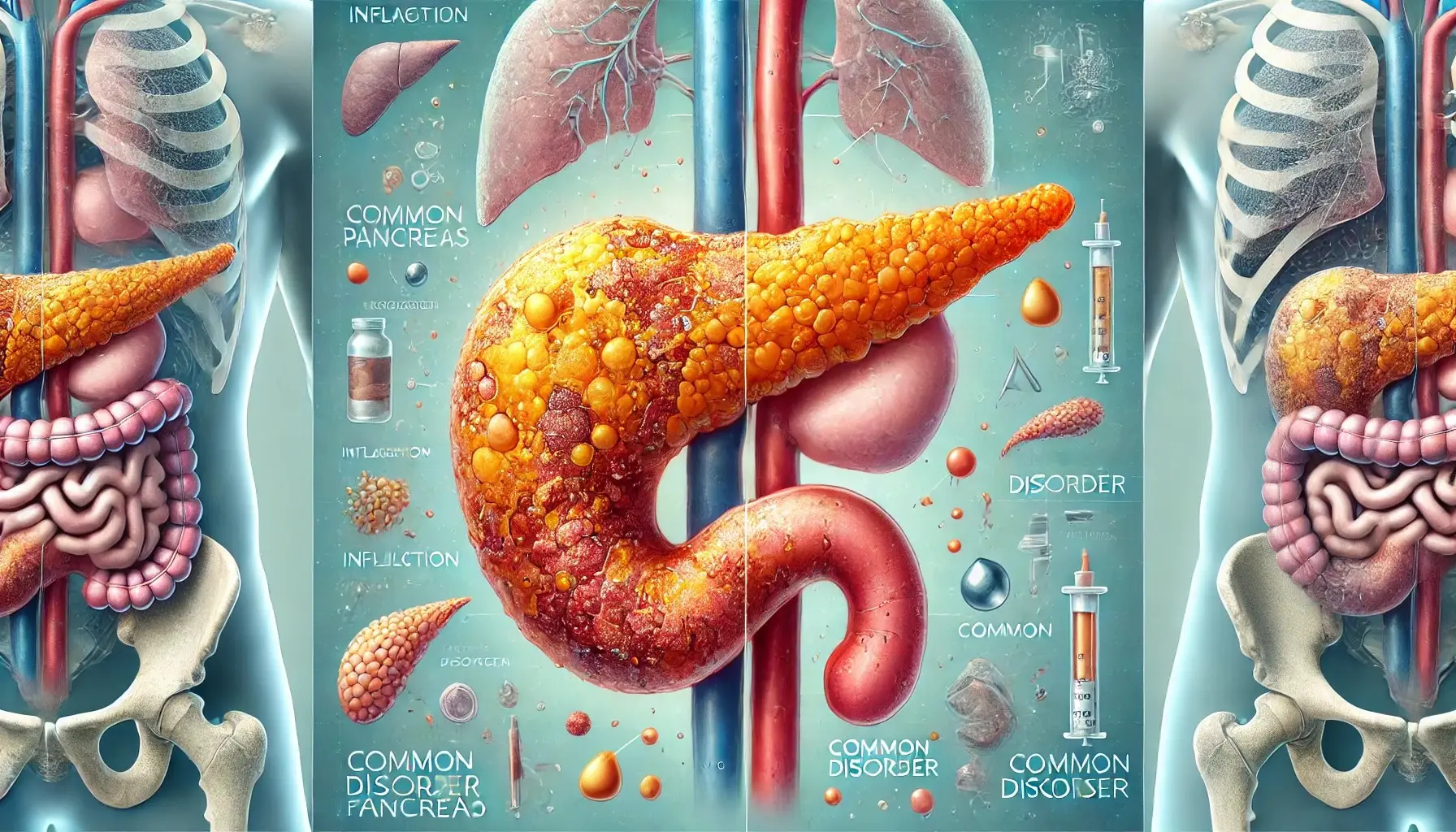
[…] proven yoga poses to heal your pancreas and improve overall health naturally. Enhance your wellness with these […]